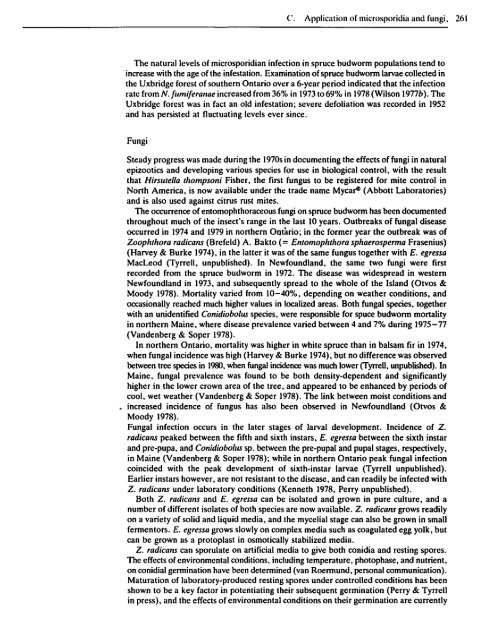pdf, 57.71Mb - Entomological Society of Canada
pdf, 57.71Mb - Entomological Society of Canada
pdf, 57.71Mb - Entomological Society of Canada
Create successful ePaper yourself
Turn your PDF publications into a flip-book with our unique Google optimized e-Paper software.
C. AppliclItion <strong>of</strong> microsporidia and fungi. 261<br />
The natural levels <strong>of</strong> microsporidian infection in spruce budworm populations tend to<br />
increase with the age <strong>of</strong> the infestation. Examination <strong>of</strong> spruce budworm larvae collected in<br />
the Uxbridge forest <strong>of</strong> southern Ontario over a 6-year period indicated that the infection<br />
rate from N.fllmiferanae increased from 36% in 1973 to 69% in 1978 (Wilson 1977b). The<br />
Uxbridge forest was in fact an old infestation; severe defoliation was recorded in 1952<br />
and has persisted at fluctuating levels ever since.<br />
Fungi<br />
Steady progress was made during the 1970s in documenting the effects <strong>of</strong> fungi in natural<br />
epizootics and developing various species for use in biological control, with the result<br />
that Hirslllelia thompsoni Fisher, the first fungus to be registered for mite control in<br />
North America, is now available under the trade name Mycar® (Abbott Laboratories)<br />
and is also used against citrus rust mites.<br />
The occurrence <strong>of</strong> entomophthoraceous fungi on spruce budworm has been documented<br />
throughout much <strong>of</strong> the insect's range in the last 10 years. Outbreaks <strong>of</strong> fungal disease<br />
occurred in 1974 and 1979 in northern Ontario; in the former year the outbreak was <strong>of</strong><br />
Zoophlhora radicans (Brefeld) A. Bakto (= Entomophthora sphaerosperma Frasenius)<br />
(Harvey & Burke 1974), in the latter it was <strong>of</strong> the same fungus together with E. egressa<br />
MacLeod (Tyrrell, unpublished). In Newfoundland, the same two fungi were first<br />
recorded from the spruce budworm in 1972. The disease was widespread in western<br />
Newfoundland in 1973, and subsequently spread to the whole <strong>of</strong> the Island (Otvos &<br />
Moody 1978). Mortality varied from 10-40%, depending on weather conditions, and<br />
occasionally reached much higher values in localized areas. Both fungal species, together<br />
with an unidentified Conidiobo/w species, were responsible for spuce budworm mortality<br />
in northern Maine, where disease prevalence varied between 4 and 7% during 1975-77<br />
(Vandenberg & Soper 1978).<br />
In northern Ontario, mortality was higher in white spruce than in balsam fir in 1974,<br />
when fungal incidence was high (Harvey & Burke 1974), but no difference was observed<br />
between tree species in 1980, when fungal incidence was much lower (TyrreU, unpublished). In<br />
Maine, fungal prevalence was found to be both density-dependent and significantly<br />
higher in the lower crown area <strong>of</strong> the tree, and appeared to be enhanced by periods <strong>of</strong><br />
cool, wet weather (Vandenberg & Soper 1978). The link between moist conditions and<br />
• increased incidence <strong>of</strong> fungus has also been observed in Newfoundland (Otvos &<br />
Moody 1978).<br />
Fungal infection occurs in the later stages <strong>of</strong> larval development. Incidence <strong>of</strong> Z.<br />
radicans peaked between the fifth and sixth instars, E. egressa between the sixth instar<br />
and pre-pupa, and Conidiobolus sp. between the pre-pupal and pupal stages, respectively,<br />
in Maine (Vandenberg & Soper 1978); while in northern Ontario peak fungal infection<br />
coincided with the peak development <strong>of</strong> sixth-instar larvae (Tyrrell unpublished).<br />
Earlier instars however, are not resistant to the disease, and can readily be infected with<br />
Z. radicans under laboratory conditions (Kenneth 1978, Perry unpublished).<br />
Both Z. radicans and E. egressa can be isolated and grown in pure culture, and a<br />
number <strong>of</strong> different isolates <strong>of</strong> both species are now available. Z. radicans grows readily<br />
on a variety <strong>of</strong> solid and liquid media, and the mycelial stage can also be grown in small<br />
fermentors. E. egressa grows slowly on complex media such as coagulated egg yolk, but<br />
can be grown as a protoplast in osmotically stabilized media.<br />
Z. radicans can sporulate on artificial media to give both conidia and resting spores.<br />
The effects <strong>of</strong> environmental conditions, including temperature, photophase, and nutrient,<br />
on conidial germination have been determined (van Roermund, personal communication).<br />
Maturation <strong>of</strong> laboratory-produced resting spores under controlled conditions has been<br />
shown to be a key factor in potentiating their subsequent germination (Perry & Tyrrell<br />
in press), and the effects <strong>of</strong> environmental conditions on their germination are currently
















